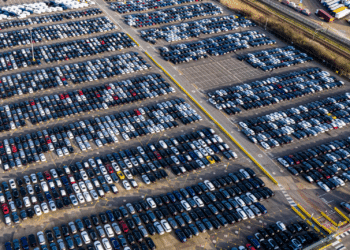Remodeling Residuals: As Autonomous Technology Matures, Will Today’s Cars Face A Steep Residual Drop?
There are currently about 1.4 billion cars on the road. By 2020, many of those cars — and eventually all, in the much longer term — are predicted to be replaced by self-driving vehicles.
But in the transition to fully autonomous vehicles, a deluge of early semiautonomous iterations are expected to flood the used-car market where their technological obsolescence could prompt residual values to fall by as much as 50% in the next few years, according to a Morgan Stanley report.
In the next three years, 12 million vehicles are expected to reach the end of their lease terms, Deloitte Consulting LLC reported in January. Notably, leasing as a percentage of auto financing has grown to 24% in 2016, from 15.7% in 2011, according to Big Wheels Auto Finance 2017.
There are a few contributing causes to the stark residual impact that is expected to occur in the next few years, including a changing attitude from millennial customers toward leases, the impact of autonomous technology on safety, and over-the-air updates keeping vehicles up-to-date for longer.
But there is also a consensus that, eventually, as automakers reach autonomous parity with one another, the residual value market will look very similar to the way it does now with vehicles that have little-to-no autonomy.
Millennial Mindset
Leases have historically been viewed as a niche product for wealthy buyers of luxury automobiles, Andre Salz, Deloitte’s U.S. auto finance lead, told AFN. But as time goes by, millennials have come to view leases as an opportunity to possess the latest automotive technology that is under warranty coverage for the duration of their lease.
“We fully believe that once we get into full autonomy, those cars will have to be written off much sooner,” he said. “The pace of technology will continue to erode the residual values … millennials and others are wanting the latest tech, and with that pace, no one will want a three-year-old car with old technology.”
Something as small as a 5% decrease in residual values could lead to a $7 billion shock to the auto finance industry, according to Deloitte’s report. On the heels of increased interest in leasing, driven in part by millennials, there’s also a shifting perspective on what it means to own a vehicle.
Millennials are driving less and getting their driver’s licenses and cars later in life. At the same time, more carsharing, ride-sharing, and car subscription companies are cropping up, each catering to this shifting attitude.
“As we move more toward an autonomous world, we are expecting the ownership model to change from individual ownership toward fleets of vehicles and carsharing,” Salz said.
The impact of this change goes beyond simply fewer cars being bought or sold, but also on mileage racked up per vehicle. Mileage is one of the predominant ways to determine value, but with the shift to joint ownership or carsharing, fewer cars will collectively share more miles. In this future, the convergence of autonomous cars and vehicle-sharing means most car sales will shift to commercial fleet sales, away from a world of private ownership of driver-operated cars, according to a September 2015 report from Deloitte.
This convergence could also spur the burgeon of small, low-cost electric vehicles. Additionally, the convergence could prompt the lifetime of a vehicle to increase to more than 240,000 miles and maximize the utilization of the vehicle to at least 70,000 miles per year, as compared to today where the vehicle lifespan is around 151,000 miles with a utilization of around 13,000 miles per year.
Safety First
In 2016, 20 automakers signed a memorandum of understanding with the U.S. Department of Transportation’s National Highway Traffic Safety Administration (NHTSA) and the Insurance Institute for Highway Safety to apply standard automatic emergency braking (AEB) to most vehicles by 2022.
AEB is only one example of the dozens of safety features that semi-autonomous or driver-assisted technology represents. With safety in focus, features like AEB could quickly become standard in new cars, a shift that bodes well for road safety, but “could also cause collateral damage in the used-car market, which carries a value of up to $2 trillion in the U.S. and as much as $7 trillion globally,” according to Morgan Stanley February 2017 report. “Current-market used cars could lose half their value by 2021, affecting secondhand car dealerships, auto financing, and insurance, among other sectors.”
On average, a new car can lose up to 60% of its total value over the first five years, according to May 2017 CarFax data. Right now, most automakers either don’t offer semi-autonomous safety features or only offer them as optional upgrades.
“For example, only 12% of vehicles sold in the U.S. come with automatic emergency braking,” according to the Morgan Stanley report. However, Toyota Motor Corp. equipped 56% of its 2017 fleet — 1.4 million vehicles — with AEB, according to a December 2017 NHTSA report.
Semi-autonomous safety features are expected to be standard on 85% of new cars sold in the U.S. by 2020, Adam Jonas, a Morgan Stanley auto analyst, said in the report.
“This penetration of [advanced driver assistance systems] to near 100% could progress twice as fast as the market anticipates, due mainly to competitive reasons,” he added.
American Honda Motor Co. is one of those automakers dedicated to making ADAS technology available on one of its models, but the OEM does not refer to it as “semi-autonomous,” Chris Martin, a Honda spokesman, told AFN. “The Honda Sensing and AcuraWatch safety suites are considered [by the Society of Automotive Engineers] Level 1 — if a high\ Level 1,” he said.
In the five levels delineating autonomy, Level 1 involves the human and a computer system working together on tasks, with most of the work being done by the person at the wheel. Under SAE and NHTSA guidelines, that is defined as “driver assistance.”
“With that being said, these systems do offer features that are bridge technologies toward more autonomous features of the future including automatic emergency braking … lane-keep assist [steering assistance], and adaptive cruise control,” he said.
While some automakers separate out AEB as a standalone feature, Honda has added it to both its Honda Sensing and AcuraWatch driver-assisted technologies.
“Thus, by 2022, nearly all of our vehicles will include [these] features and potentially more,” he said. Going back to the 2015 CR-V, Honda now has well over one million vehicles on the road equipped with Honda Sensing or AcuraWatch. “The bottom line is that there soon will be no option to not have this technology in our vehicles,” the spokesman said. “Accord is already there, as is the entire Acura brand. Thus, there will be no question of residual difference within any particular Honda model line very soon.”
As safety features become more mainstream, “the average used car may be seen as a substantially inferior mode of transportation, an unacceptable safety risk, difficult to insure, and worth less at auction,” Jonas said in the Morgan Stanley report. In a typical economic downturn, used-car prices might drop 15% to 20%, but their accelerated obsolescence could prompt prices to fall as much as 50% over the next few years, according to the report.
Banks with exposure to the auto sector would also be affected, Betsy Graseck, another Morgan Stanley analyst who covers U.S. large-cap banks, said in the report. The biggest impact would be in the auto lease portfolios where residual values could decline.
Auto loan portfolios would be hit, too, as the severity of losses tied to car loans rise. Over-the-Air Competition Elon Musk, chief executive of Tesla Motors Inc., rejected the idea of offering lower monthly lease payments to drive consumer demand during a first-quarter 2017 earnings call.
The software in Tesla vehicles “keeps getting better,” Musk said at the time, referencing over-the-air updates the automaker implements to its Enhanced Autopilot autonomous software system. “We keep adding more and more functionality to the car, even though the hardware has stayed the same,” he said. “If you bought the Model S four years ago, it is way better [now] than when you bought it, and that really makes a difference for residuals.”
Over-the-air updates to Tesla’s Enhanced Autopilot is currently the automaker’s not-so-secret sauce to maintaining agility in the semi-autonomous space.
The residual performance of Tesla cars consistently outperforms other electric vehicles, Mike Vogan, lead auto economist at Moody’s Analytics, told AFN. But this outperformance isn’t necessarily because of over-the-air updates.
“It’s kind of hard to estimate how much value customers are putting on that add-on [Enhanced Autopilot] feature,” Vogan said. Tesla, however, attributes over-the-air updates to upholding its vehicles’ residual values, a Tesla spokeswoman told AFN. “In terms of residual value, Tesla vehicles are known to have among the strongest residual value of any premium sedan or SUV,” she said. “This is largely due to factors like Supercharging, data connectivity, free software updates, and less required maintenance.”
But at $5,000, not every customer — yet — is ordering Tesla’s Enhanced Autopilot software feature to be activated — even though the hardware is standard in all of the OEM’s vehicles. Eventually, over-the-air updates will become a requirement, Anil Goyal, executive vice president of operations for Black Book, told AFN.
“I think software will become more commonplace for manufacturers,” he said. “But there is a distinction between software upgrades and hardware upgrades … there will be points where software and hardware will both have to be upgraded.”
In addition to hardware upgrades, there is also the concern over electric vehicles, which are currently experiencing their own rapid technological advancements. During the Q&A portion of Tesla’s annual shareholder meeting last June, a question was posed to Musk, asking if Tesla would offer battery upgrades for older models of Model S and X to maintain their resale values. Musk said it would not make financial sense for consumers to upgrade just the battery pack; instead, it would be better to sell the car and then buy a different one.
“The innovation and battery life is a much more pressing concern than semiautonomous technology [on residual performance],” Vogan said, adding that newer electric vehicles marginally hurt older ones. Tesla previously offered a Resale Value Guarantee (RVG) program for the Model S after three years when purchased through the company’s financing program, but Tesla ended the program in 2016.
“We discontinued the RVG program because it was no longer something that our customers were asking for in North America,” the spokeswoman said. “Instead, there was a larger need for a lease product, which we started offering.”
Tesla isn’t the only company to have a car that features electric and semiautonomous duality. Automakers like Volvo Car USA and BMW Group AG have both features in their vehicles. For example, Volvo’s Pilot Assist semi-autonomous technology is a standard feature on the CX90 and S90, much like Tesla.
“Pilot Assist is generally one of the most valuable single options on a new Volvo, and we expect cars equipped with it to continue to have stronger residual values than cars without it,” Russell Datz, spokesman for Volvo Car USA told AFN.
With that in mind, there’s a potential risk for semi-autonomous cars to “cannibalize” non-autonomous ones, Vogan said. A prime example of this happening would be iPhone sales. “You can update the [iPhone] software for functionality … but the iPhone X comes along and becomes the standard for the most cutting-edge technology,” which eats away at the sales for all other models. And eventually, your iPhone’s hardware cannot keep up with newer models even if you continue to update the software.
The same goes for automakers. “It’s unlikely that Tesla, or anyone else, has stumbled upon the perfect hardware [yet],” Vogan said.
Driving Into the Future
There are some foggy messages surrounding autonomous cars, and when fully autonomous ehicles will be available to the larger public. Delphi Automotive, Intel, and Mobileye have all promised Level 4 hardware and software systems available to automakers by the end of 2019, with vehicles using that system coming to the market by 2021.
Additionally, General Motors Co. is expected to have Level 4, high automation, vehicles operating in ridehailing services in dense urban areas at scale by 2019, according to Bloomberg. Stealth tech company Zoox plans to begin picking up customers in autonomous vehicles by 2020. But what is clear is that tech companies, automakers, and Tier 1 and 2 suppliers — vendors that supply parts or systems directly to OEMs — are all onboard with making this autonomous dream a reality.
To that end, if every car has autonomous technology then there’s nothing special or unique about them anymore. Residual values are, therefore, unlikely to be buoyed by autonomous tech. But until then, the industry still has to reckon with the technology in cars today that will be obsolete in a few years. “We do think the industry is facing a lot of pressure of residuals, and now is the time to be proactive and use tools like advanced analytics and dealer programs to get ahead of that wave,” Deloitte’s Salz said. “With improved modeling we think companies can … manage the [residual] impact much better.”
For example, model redesigns through engineering and large sales incentives could drive a decrease in residual market values, according to the Deloitte report. “Finance companies can adjust their pricing and leverage their dealership relationships (both guided by advanced predictive models) to minimize off-lease returns, and work with vehicle remarketing team members to maximize the auction price of returned vehicles,” Salz said.
At the end of the day, used-car buyers are seeking value. Each innovation, from lane assist to self-parking, is a step toward fully autonomous vehicles and simultaneously allows a manufacturer to test the market on how these latest technologies are viewed. But because these semi-autonomous cars were only recently introduced, they will not be available — for the most part — on the used market for the next year or two.















